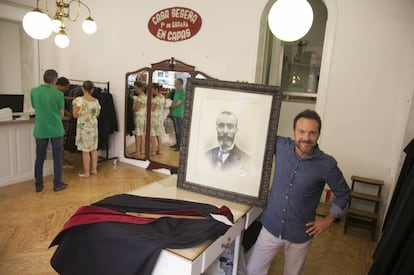In Madrid a dwindling number of historic shops resist globalization
A new book catalogues the histories of some of the oldest establishments in the capital

Legend has it that a Venetian alchemist came to Phillip II with a unique solution to his financial woes by using the dark arts to create the silver needed to pay his vast army. It is also said that this mysterious alchemist is the founder of the oldest surviving establishment in Madrid: La Antigua Farmacia de la Reina Madre.

Since it opened in 1578, the pharmacy has remained at its original location on Mayor street, 59. The pharmacy catered to the monarchy so much that Philip V awarded the business a royal shield in the early 1700s. There used to be a tunnel that connected the shop with the nearby Royal Palace, but it is now sealed off. Among its many relics is a jar that contains the dusty remains of a mummy and a prescription that belonged to Miguel de Cervantes.
Changes in consumption are contributing to the closure of traditional businesses Gumersindo Fernández
A new book, Comercios históricos de Madrid (Historic Shops of Madrid) by Enrique Ibáñez and Gumersindo Fernández, tells the stories of several of the oldest businesses in the capital. Among them is this ancient wood-paneled pharmacy still very much in business, along with other venerable establishments holding out against the fast food franchises and cheap clothing stores taking over so many city centers.The book highlight the success stories, while lamenting the loss of those that have succumbed.
“In the last few years, older businesses have been disappearing due to rising rents in center, along with competition from bigger companies,” says Ibáñez. Other factors include rampant gentrification and increased tourism. The result, according to the authors, is the loss of many cities’ character in line with global uniformity. The biggest stores in different cities all over the world are often the same. “This loss of identity is one of the negative consequences of globalization,” says Fernández.
The historic San Ginés chocolatería continues to sell 4,000 churros a day
A place the visitor to Madrid is unlikely to have come across anywhere else is the Botería de Julio Rodríguez (Canalejas street, 6), which sells handmade wineskins and wine barrels. Founded in 1909, the establishment is home to the last wineskin craftsman in Madrid. Rodríguez adheres to the traditional methods of creating these wineskins from goat’s skin. Another gem is La Violeta (Canalejas Plaza, 6), which sells violet candles that have been made the same way since 1915.
The historic San Ginés chocolatería (San Ginés street, 5) is also featured in the book. The 24-hour bar famous for its hot chocolate was founded in 1894 and continues to sell about 4,000 deep-fried batter churros to dip in it a day, attracting tourists and locals. Ramón del Valle-Inclán’s Bohemian Lights featured San Ginés prominently.
Other historic stores to look out for when wandering the streets of Madrid include candy store Caramelos Paco, the La Mallorquina bakery, historic restaurant Lhardy, and Capas Seseña, which has been making traditional Spanish capes since 1901.
Botín, founded in 1725, displays its Guinness Book of Records plaque declaring it the oldest restaurant in the world
The authors say that commerce in Madrid developed in the nineteenth century with international influence from Paris and the United States. Shops underwent a revolution in the 20th century with the arrival of international stores, luxury hotels and major thoroughfares such as the Gran Vía. From the 1950s onward, Madrid sold itself as a modern city, a process that continued after the death of General Francisco Franco in 1975.
“Changes in consumption are contributing to the closure of traditional businesses,” says Fernández. “So the challenge that older places face is knowing how to modernize and keep up with rapidly changing times.” This involves both updating their products and looking for new business models, like internet sales. For example, Capas Seseña has a modern website and promotes the hashtag #capethefuture. With marketing, businesses can also turn their age into an advantage. Botín, a restaurant founded in 1725, proudly displays its Guinness Book of World Records plaque declaring it the oldest restaurant in the world.
The historic Café de Fornos has since been replaced with a Starbucks
The authors say that the tourism boom saved the hotel industry, but has led to the demise of many small businesses that were hurt by rising rents. Old businesses have not been protected by city planners, but if they are located in a listed building, that can offer some help. City Hall also has an app called Comercios Centenarios de Madrid featuring many of the shops mentioned above. In 2006, many such establishments were also awarded a plaque designed by Spanish cartoonist Antonio Mingote, famous for his depictions of Madrid life.
The new book also features various establishments that have since closed, such as the punk rock bar Ágapo and the Rock-Ola concert venue. The historic Café de Fornos has since been replaced with a Starbucks, while the El Águila brewery is now a library. Ibañez y Fernández hope that their book not only showcases these different businesses but helps to gain a deeper understanding of the city’s history as a whole.
English version by Debora Almeida.
Tu suscripción se está usando en otro dispositivo
¿Quieres añadir otro usuario a tu suscripción?
Si continúas leyendo en este dispositivo, no se podrá leer en el otro.
FlechaTu suscripción se está usando en otro dispositivo y solo puedes acceder a EL PAÍS desde un dispositivo a la vez.
Si quieres compartir tu cuenta, cambia tu suscripción a la modalidad Premium, así podrás añadir otro usuario. Cada uno accederá con su propia cuenta de email, lo que os permitirá personalizar vuestra experiencia en EL PAÍS.
¿Tienes una suscripción de empresa? Accede aquí para contratar más cuentas.
En el caso de no saber quién está usando tu cuenta, te recomendamos cambiar tu contraseña aquí.
Si decides continuar compartiendo tu cuenta, este mensaje se mostrará en tu dispositivo y en el de la otra persona que está usando tu cuenta de forma indefinida, afectando a tu experiencia de lectura. Puedes consultar aquí los términos y condiciones de la suscripción digital.
More information
Archived In
Últimas noticias
Maduro pleads not guilty before the federal court in New York: ‘I am still the president of Venezuela’
A new test can detect Alzheimer’s from a finger prick
UN team enters Sudanese city of El Fasher after paramilitary massacre: ‘It’s like a ghost town’
A recipe for resistance: Indigenous peoples politicize their struggles from the kitchen
Most viewed
- Gilles Lipovetsky: ‘If you want to live better and fall in love, take Prozac, don’t look to philosophy’
- Alain Aspect, Nobel laureate in physics: ‘Einstein was so smart that he would have had to recognize quantum entanglement’
- Alvin Hellerstein, a 92-year-old judge appointed by Bill Clinton, to preside over Maduro’s trial in New York
- Maduro’s downfall puts China’s relationship with Venezuela to the test
- Why oil has been at the center of Venezuela-US conflicts for decades










































